When I was in the midst of blogging about embarrassing myself at a myriad horse sports (polo, vaulting, racing, driving, eventing, endurance), a dear friend and eventer, Grace Busse, commented on my vaulting blog saying: “If you do reining and dressage, you’ve tried every sport at the World Equestrian Games, yeah?”
Yes, indeed, she was right! And how cool would it be to say I bumbled my way through trying all the WEG sports? Unfortunately, I didn’t have time during my summer internship with the Chronicle in Middleburg to check reining or dressage off my “to-try-and-fail-at-with-gusto” bucket list.
So when an interview for a profile on barn manager Kira Johnson turned into an invitation to come take a reining lesson with Dave Moore at Sheridan Oaks Stables in Fort Lauderdale while I’m stationed in Wellington, Fla., for the winter, I jumped at the opportunity!
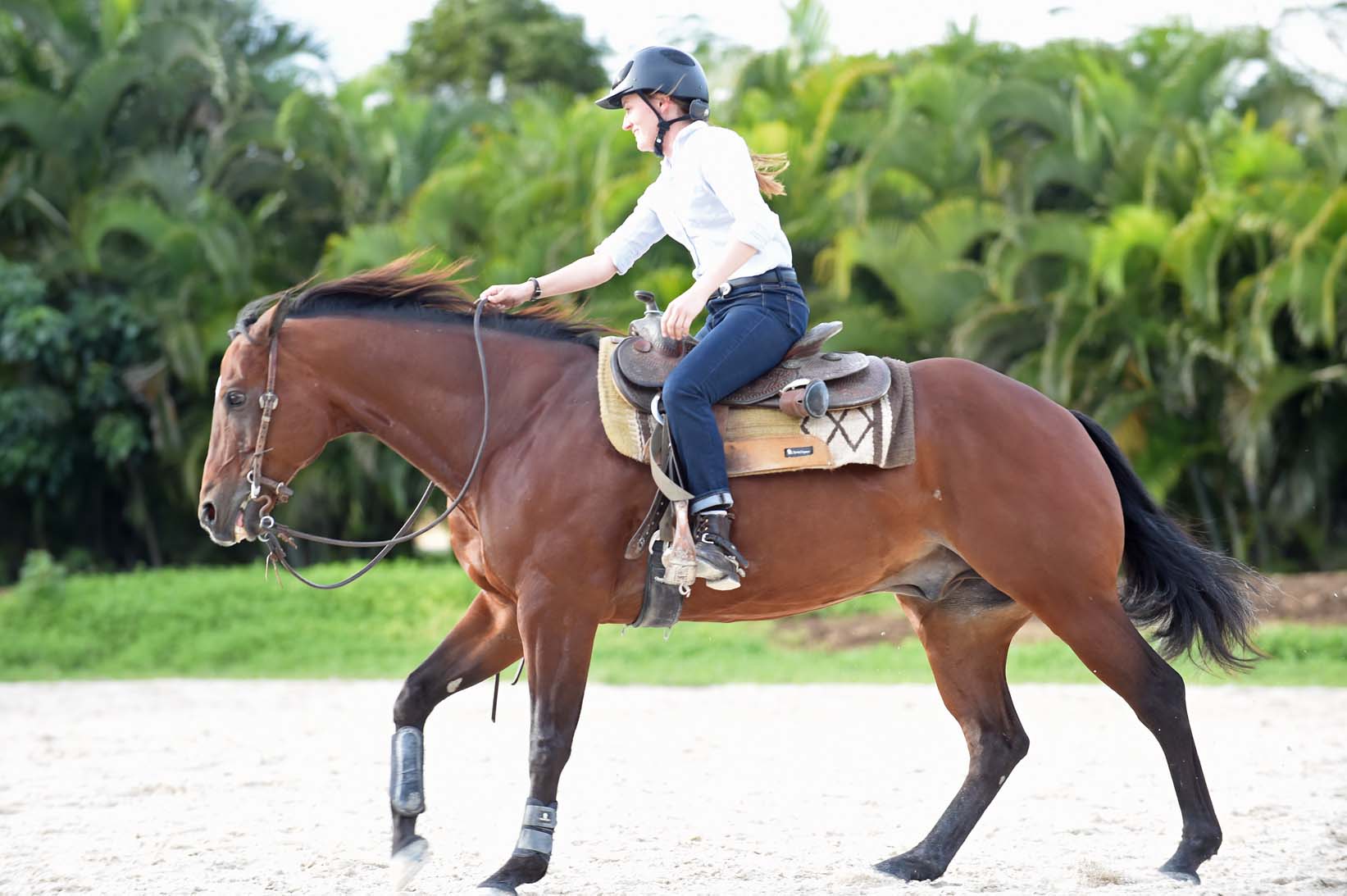
Galloping along in a lesson with Dave Moore aboard Taxi, just like the cowgirl I always wanted to be! All photos by Katie Lange-Lima
Now to be fair, I am not a total newbie to reining. Back in high school in my hometown of Cedar Rapids, Iowa, my trainer Katie and I convinced a girl who had her very broke, very made reining horse boarded across the aisle to let us both hop on and have a “rein off.” We had the western trainers in the barn judge, and I got disqualified for grabbing the horn multiple times when I was sure I was about to get spun off. Katie, for her part, almost forgot to say whoa in one of her sliding stops and nearly ran into a wall, but she won by default thanks to my disqualification.
Add that disastrous fake show experience to years of watching old westerns of cowboys rearing and firing pairs of pistols before galloping off into the sunset, and yeah, I’d say I was preeeeetty experienced in the reining department prior to this lesson.
Despite embarrassing her in every possible way as a young hunter pupil, Katie still talks to me and agreed to come watch and take pictures of the reining lesson (all pictures in the blog are taken by her!).
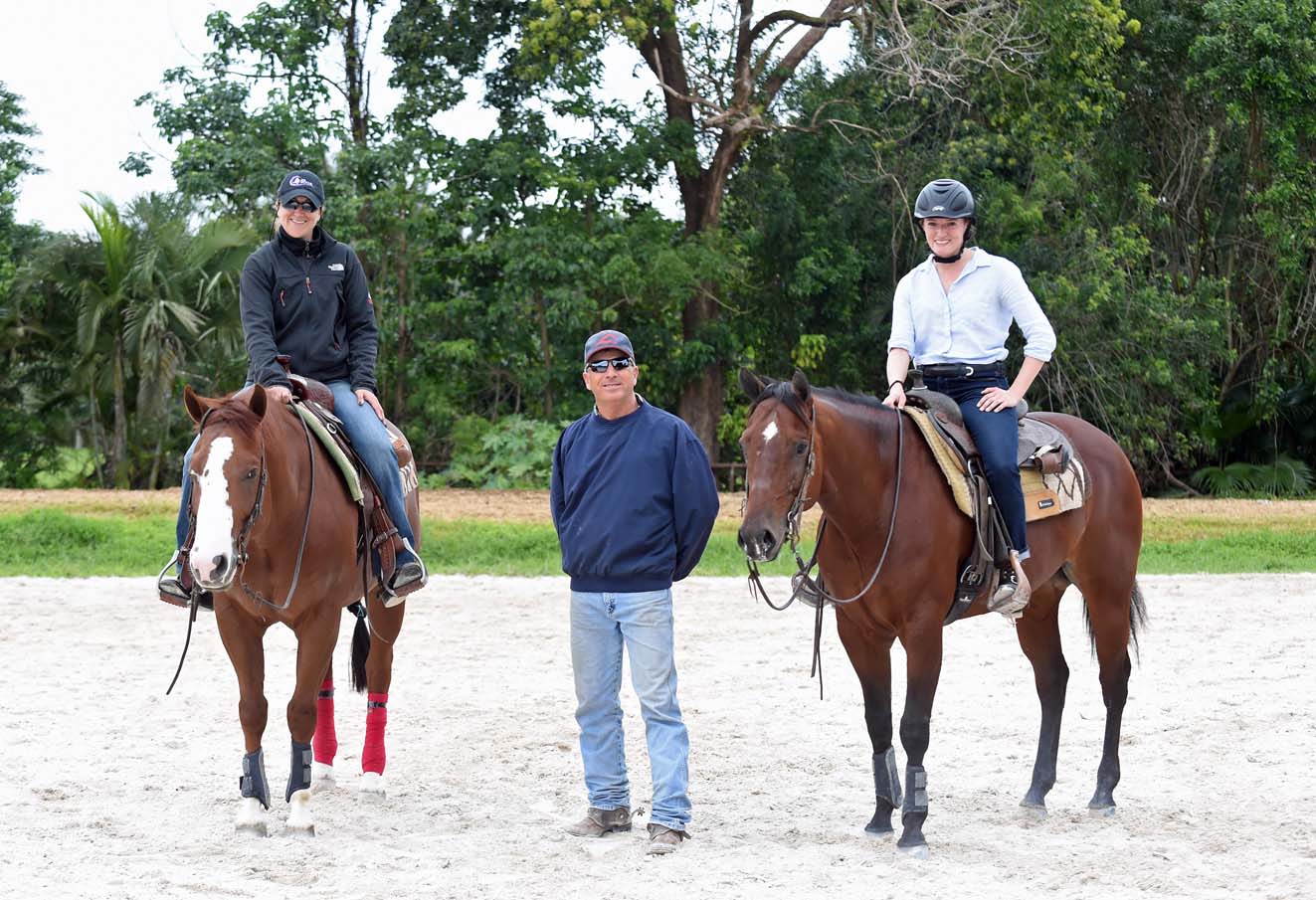
From left: Kira Johnson and the very cute Newt, Dave Moore, and me on Taxi (one of the few times he looked happy with me bumbling around on his back).
We rode together down to Fort Lauderdale from Wellington, and Kira used the drive to assure me reining would not be nearly as hard as I was remembering from one experience more than six years ago, and how the trainer we would be lessoning with, Dave Moore, was excellent at explaining things to newbies.
As promised, Dave could not have been better at breaking down the various cues and positions I needed to be in to correctly tell my horse, Taxi, to go through the different elements of a reining pattern.
And let’s talk about Taxi for a second—maybe it’s because we had our lesson a couple days after the Super Bowl, but all I could think when looking at him (and Kira’s horse, Newt) standing in the cross-ties was how excellent both horses would be at epicly pummeling other horses in an equine game of football. These are the linebackers of the hooved world—they may not be terribly tall, but I have never seen muscles that defined and rock hard on a jumping horse before.
Every part of Taxi, his neck, his shoulders, his massive hindquarters, made it look like he could pull a freight train out of a snow bank and still wouldn’t skip his afternoon lift session.
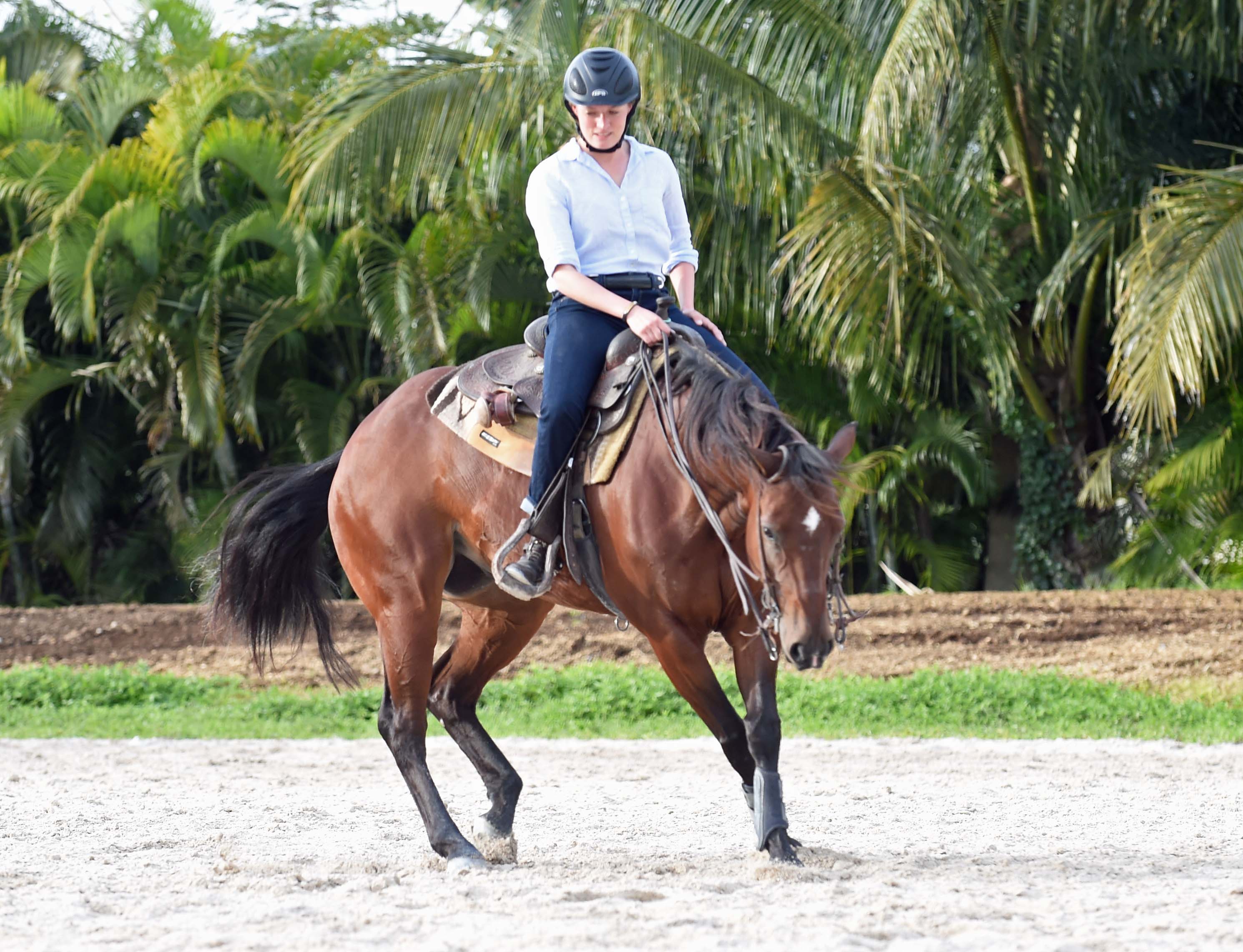
Taxi showing off his muscles mid-spin.
As I brushed Taxi off and oogled at his muscles, I believe I saw the first of many equine eye rolls during our brief afternoon together, something to the tune of, “Yeah, I’m totally ripped, Captain Obvious. When’s the last time you worked out? When you went to take your pizza rolls out of the freezer and they fell all over the floor, resulting in a mad dash of lunges to get them all on a plate before the five second rule expired?”
Incredibly astute and specific of you, Taxi. That IS the last time I worked on my cardio.
More shade was thrown and eyes rolled at my total obliviousness to putting on western tack—we weren’t even in the ring yet, but Taxi was already catching on to my newbie status. Cinches were not a part of my hunter vocabulary. Thankfully, grooming a horse is not discipline-specific, so I did that and let Kira and Dave show me how to properly swing the saddle over and tighten the cinch.
OK, the horse is ready! The tack is on! Here comes the fun part—riding!
After climbing up onto poor Taxi like a couch from the ground, in the only uncoordinated maneuver I could manage, we were ready to rock! Well, kind of ready, but really not ready at all, because everything from how I held the reins, which were split, not connected by a buckle, to how I used my legs on the saddle and Taxi’s sides, had to change.
No wrapping the leg around and gripping with my calves and thighs like I’d been drilled on my whole hunt seat equitation life—Dave wanted me to just let my leg hang loose, and to hold slightly with my calves and use them, and if needed the small rowel spurs, to encourage Taxi forward, but no gripping and holding. Gripping would send Taxi on a rodeo around the ring, and I did learn that one the hard way later in the lesson!
For the reins, we started and warmed up holding one rein in each hand, but not in the way I was familiar with. Dave wanted me to hold my thumbs up to remind myself to keep my fists perpendicular to the ground, and to keep my hands shoulder width apart, opening one rein and touching the other to Taxi’s neck when I wanted him to turn.
ADVERTISEMENT
That was a small enough step from what I already knew and went relatively smoothly, so we progressed to hold the reins in one hand, which is how the cowboys in movies always do it and looks way cooler, so I was down to try it! (Please see picture of Taxi’s digust.)

“Go to your happy place. You’re on a beach. You have a beer. All adult amateurs perished in a targeted zombie apocalypse.” -Taxi, probably.
We started with the basics—walking, jogging (trotting) and loping (cantering) with one hand. It was remarkable how sensitive Taxi was to the cues from my legs and reins. The reins had a massive smiley face loop in them most of the time, but even slightly picking up my wrist and moving it to one side or the other had him turning honestly and sharply to the left and right, wherever in the ring I wanted him to turn. He may have been a hunk of muscle, but this guy was sensitive!
Having “mastered” (annoyed Taxi enough) with loping big and small circles, Dave had me stop in the middle of the arena to try some spins.
And when I say stop, I mean like we went from loping along at a decent pace on a circle to me saying whoa and nearly knocking my own wind out on the saddle horn when Taxi promptly planted all four feet squarely in the dirt. Whoa means something very different to a reiner than it does to a hunter. I give a long quiet whoaaaaa to my hunter to get him to slow his canter down slightly and leave a little more room on the way out of a line—I barely intoned the O vowel sound, and Taxi was at a dead halt.
Taxi stopping on a dime in the middle of the ring, me looking on in wonder.
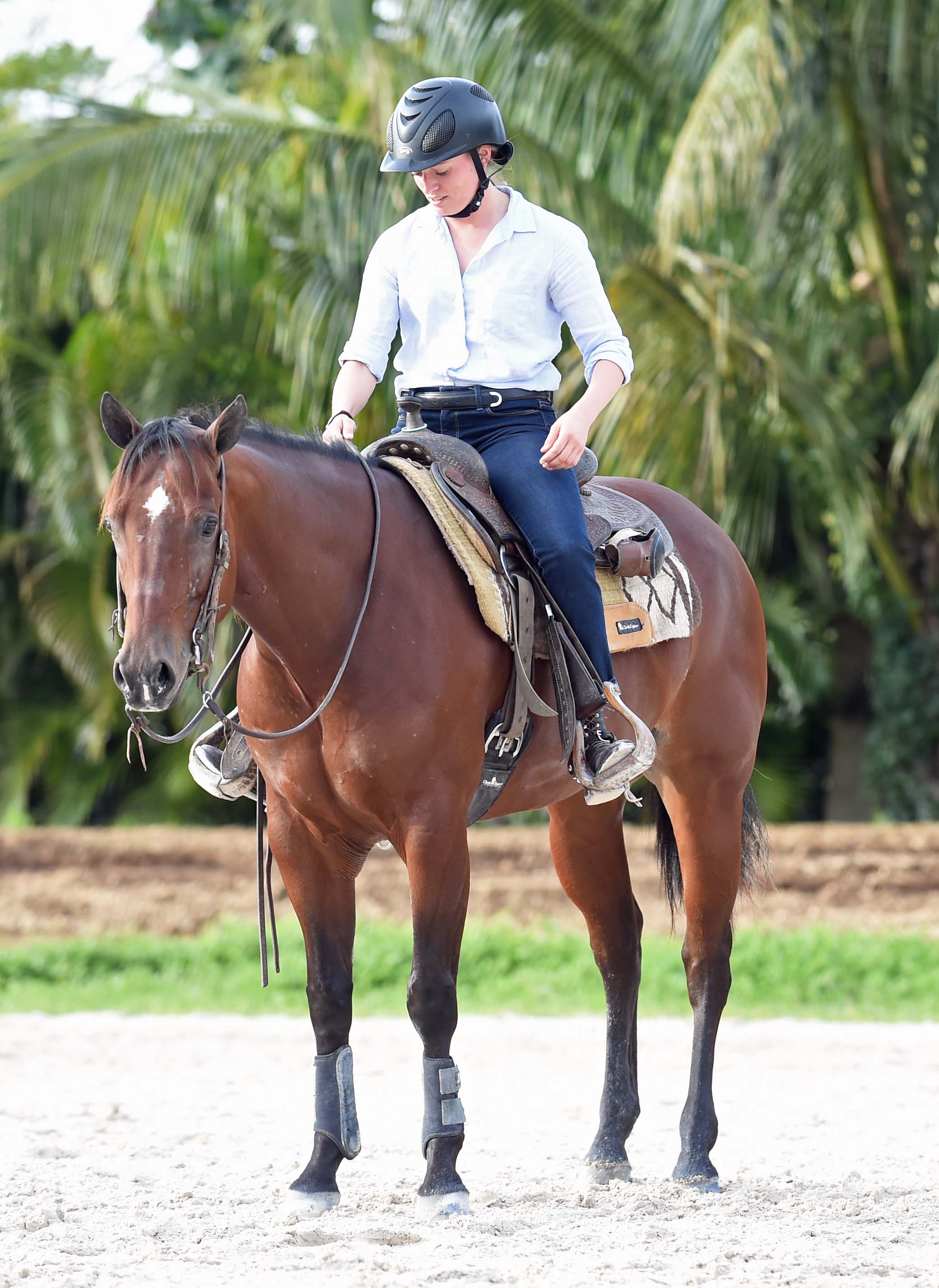
Bearing in mind that Taxi was a well tuned whoa machine, Dave began to explain the cues I would need to give to get Taxi to spin. He said I would need to take my inside leg off his side, tap my outside spur, cluck once, and open my hand to the inside.
I was waiting for the next instruction saying, “And then you guide him through the spin with your inside rein, and you bend his neck and hold him and keep him spinning.” I mean, we are essentially doing a 360-degree turn on the haunches, except we’re going to go way faster. When I turn my hunter on the haunches, we ride first and get him on the bit, get him listening to my aids, and then we walk into the turn on the haunches, and I guide him off my legs and indirect rein. He will not be doing anything resembling a turn on the haunches if I have him on the buckle, and he certainly won’t do it quickly or around his hind end.
To the contrary, Dave’s final instruction was something like, “And once he’s going, you can open you inside hand less, sit straight, and if you want him to spin faster tap with your outside leg.”
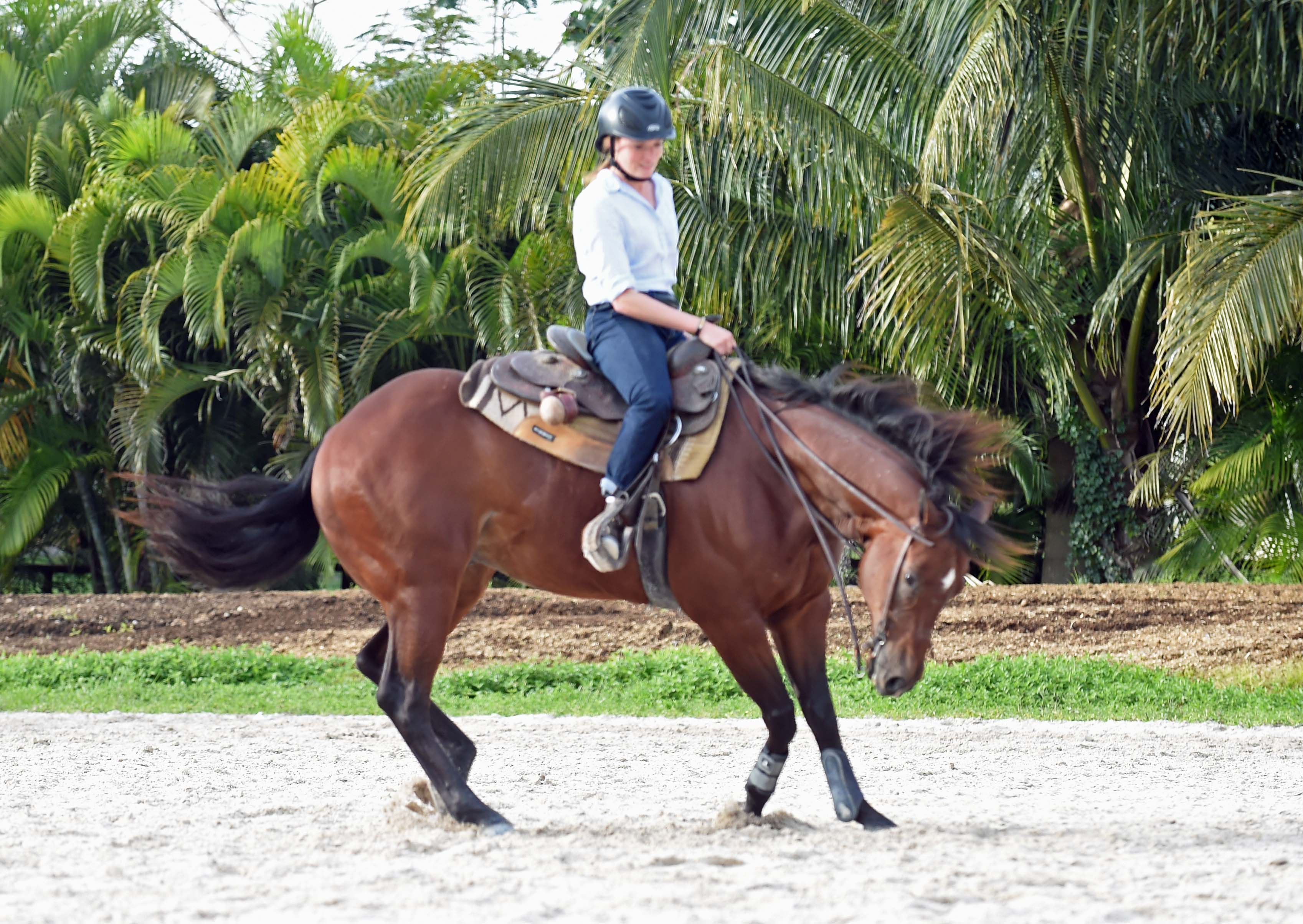
Taxi was a beast in the spins! Dave said they are one of his favorite moves, and they quickly became mine too!
I was a bit skeptical this was going to work, 1) because I can be a complete dunce when it comes to following simple directions, and 2) because these directions seemed too simple. I was waiting for the catch.
What I should have taken more into account was the fact that I was sitting on an extremely well trained animal. The 10-year-old Taxi was a superstar in the ring many years before this sack of potatoes climbed up for a lesson—under the show name Tag This, Taxi’s lifetime prize money earnings are over $30,000! At the National Reining Horse Association Derby in 2011, Taxi placed second out of 160 horses in the non-pro dvision!
Dave explained it perfectly: There is no “you-doing-anything” for the horse in those key movements, the spin and the sliding stop. You are going to ask, and if you do it correctly and they are well trained, like Taxi, they are going to do it. It’s a lot like jumping: the set-up matters, the path to the fence matters, your pace to the fence matters, but once you are in front of that jump, your job is to stay out of their way.
And stay out of Taxi’s way I did, almost too well—at one point in the spin, when Dave told me to tap a little more with my outside spur to get some more speed, I very nearly pushed Taxi into a gear that would have sent me flying off his right shoulder while he continued to spin left.
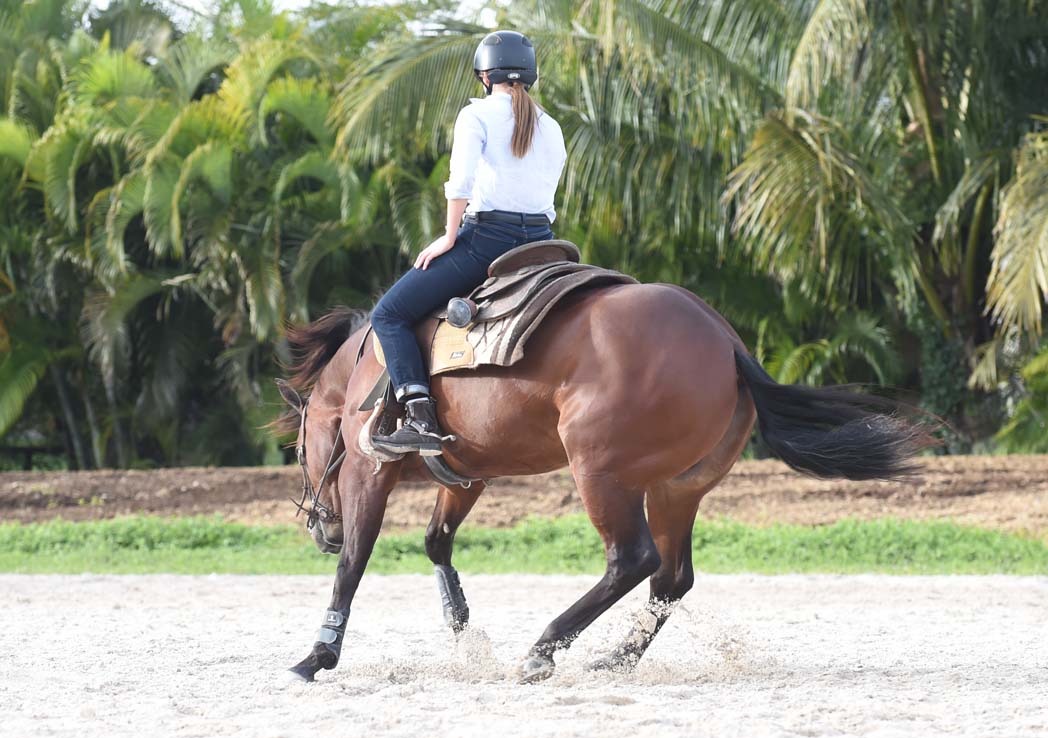
Around and around we go! In Taxi’s ideal world, until I fall off and he can continue spinning on his own, though I would prefer to stay seated until the ride has come to a complete stop.
It was like sitting in the eye of a horse hurricane—if you stayed balanced and straight in the middle, you were practically just turning around in place, but if you started to lean one way or the other—or God forbid forward—you were suddenly in the middle of the spin storm and had better right yourself before Taxi sent you flying like a boomerang (one he hoped would not return).
Now for the exciting part, what I hoped would be the most photoworthy moment of the lesson: the sliding stop! Having felt how tuned up and ready to rock Taxi was in the spin, I could only imagine how literally he was going to take my whoa when it was given mid-gallop.
Dave had me start by practicing loping where in the arena I would be running down to the stop—on the equivalent of the quarter line in hunter lingo. We loped down the straight side a few times (we previously had been working on circles), and I could tell Taxi knew what was coming next, but he waited for me to give the signal Dave called out from the middle of the ring.
ADVERTISEMENT
Once I turned the corner onto the quarter line, I was supposed to gradually build speed, and then in the middle of the ring, ask for even more, and then Dave would count, “1, 2, 3, stop,” and I would say whoa and, presumably, we would slide for 30 feet, the picture would be amazing, Dave would hire me immediately to show all his horses, and I would become the Reigning Queen of Reining. All the glory associated with that terribly pun-y title would be MINE.
Shockingly, that is not what happened—Taxi begrudgingly listened to all my fumbling cues given through Dave’s instruction and executed a perfect little sliding stop—nothing dramatic, but to someone who has never really sat that before, it felt insanely cool. I can only imagine it’s what it feels like to ride Clifford the Big Red Dog when he goes from walking through your neighborhood like Godzilla to sitting down—you go from loping along on a level-backed horse to clinging to the back of a large dog sitting down as they slide into a halt.
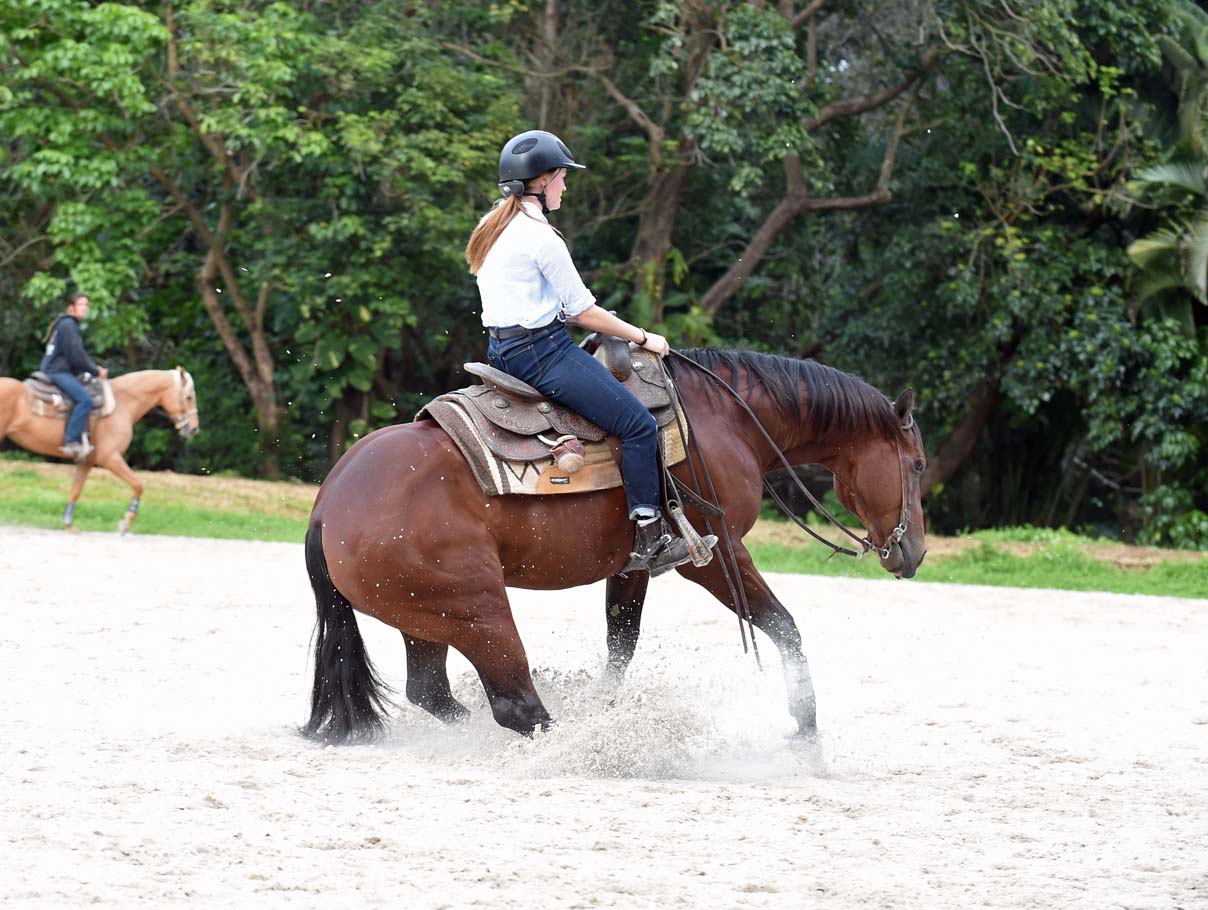
Taxi could show the equitation horses a thing or two about how to make a statement when halting in a test!
That first sliding stop we did, I came to find out, was very misleading in terms of how easy they are to pull off. It felt just like the spinning—I told Taxi what to do, he did it, I sat there and looked like my usual goony self—no problem! But Kira, who was riding around with me, assured that sliding stops were similar to jumping in the sense that they can very easily be chipped. If you aren’t ready, with your feet out and heels down and feeling the horse and correctly sensing their timing as they’re about to drop their butt down to the sand and go from 60-to-zero, you will chip.
My first sliding stop was the equivalent of someone jumping their first real vertical, and happening to luck out and canter up to a nice quiet distance. They think, “Huh, this jumping business isn’t so hard after all!” And then they canter around again and meet my dear old friend, who I see three or four times per eight-fence course: Mr. Chocolatey Chip. I met Mr. Chip in earnest on sliding stop No. 2, see photo for proof.
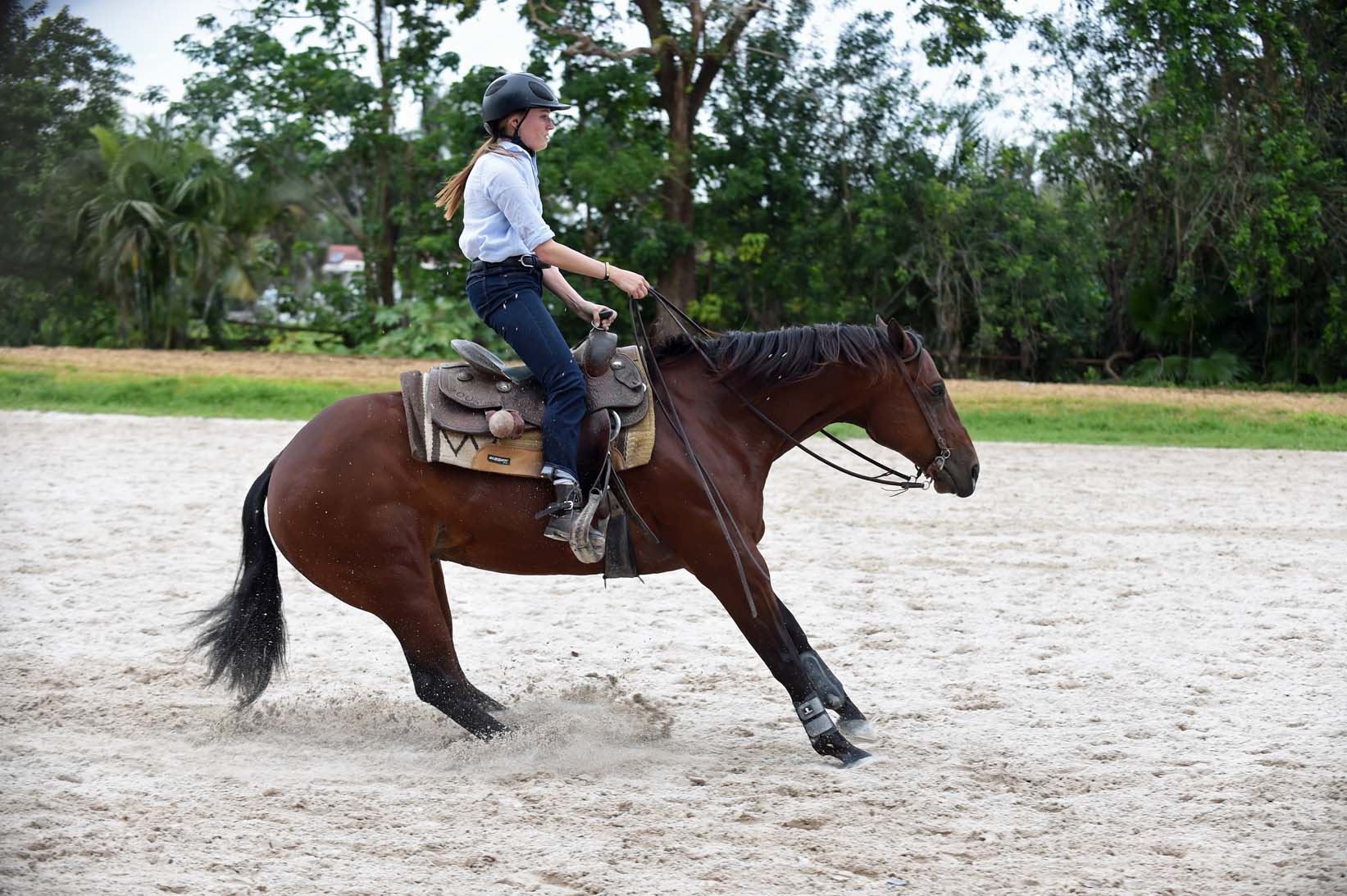
Here it comes, here it comes! Annnnnd there it goes—Taxi down for the stop, Ann up for the amateur javelin toss.
Taxi put up with my terrible sack-of-potatoes second stop with the same fortitude my poor adult amateur hunter does when he sees the single oxer across the ring, sighs, and accepts that we will gallop up to a spectacular chip-n-miss. Bless you, amateur friendly horses for resisting the urge to quietly smother us in your hay pile or drown us in your water buckets when we come into your stall and try to cuddle and apologize for our terribleness, or take silly selfies with your very dignified and un-amused self. If my hunter, Lucky, was anywhere near Florida, I would have brought him along to have a beer with poor Taxi after the lesson and commiserate over their babysitting experiences.
We ended the lesson on a good note, with one more super-fast spin, before getting off and thanking Taxi for putting up with all my hunter shenanigans. All in all, reining was seriously a complete thrill ride—I was grinning like a doofus nearly the entire lesson, particularly in the spins, which I decided were my favorite since they weren’t nearly as chip-a-ble as the stops.
I’ll be moving to Lexington, Ky., when the winter show season comes to a close, and I’d be lying if I said I hadn’t already looked into reining lesson barns in the area! (Here’s hoping Taxi doesn’t call his connections up there and warn them to just stop-drop-and-roll before I have a chance to get on.)
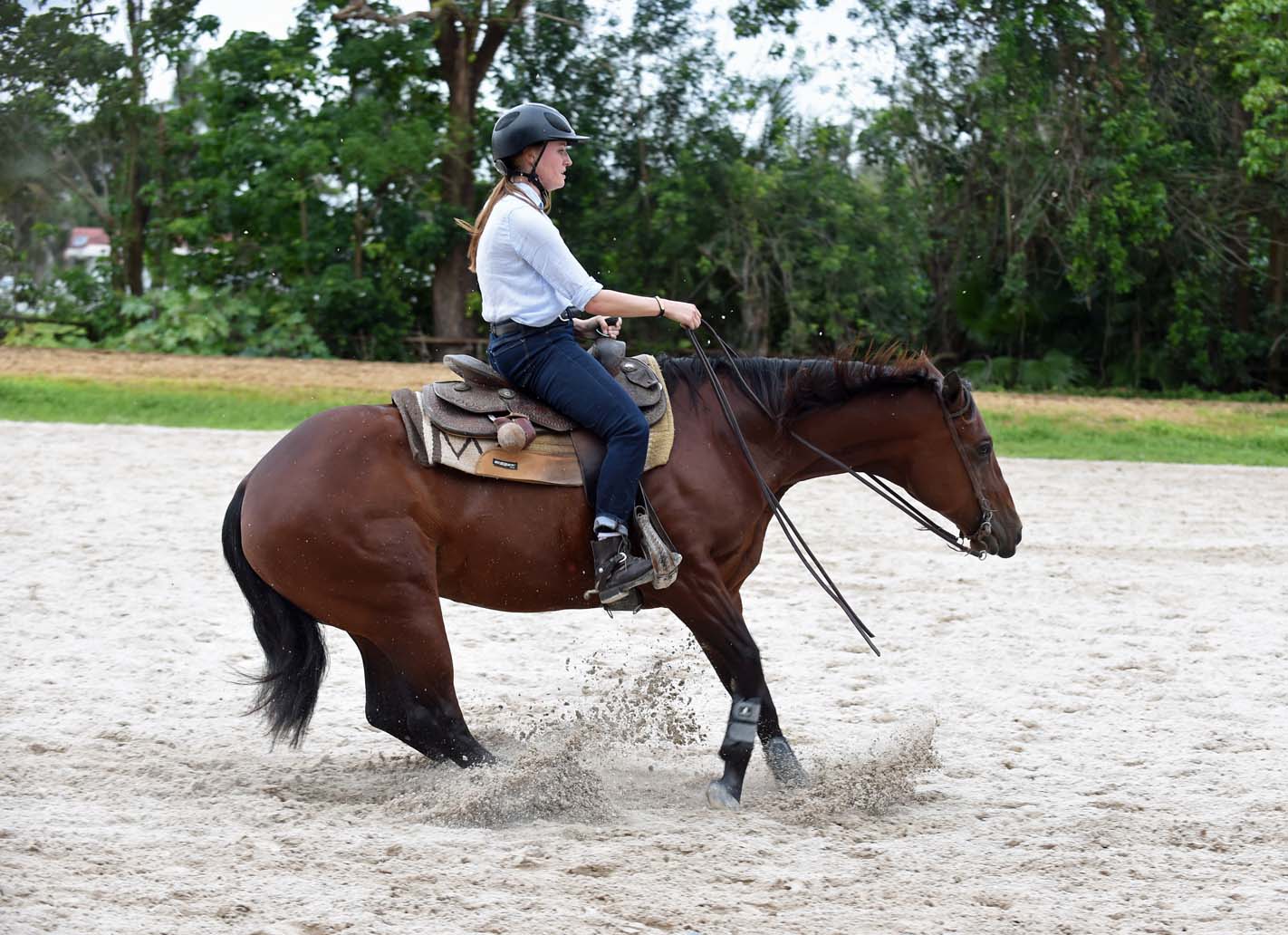
Our intrepid summer intern-then-hired-employee has been trying out all kinds of equestrian disciplines! Check out her other adventures…
Hunter/Jumper Intern Goes The Distance On 50-Mile Endurance Ride
Drive On! Hunter/Jumper Intern Tries Combined Driving, In Miniature!
At The Wire, It’s Hunter/Jumper Intern For The Win
Hunter/Jumper Intern Goes Cross-Country
Hunter/Jumper Intern Flips Out Over Vaulting
Hunter/Jumper Intern Heads To The Polo Fields
The Hunter/Jumper Intern Takes A Trip To Dressage Land
Ann Glavan was an editorial intern and now is an editorial staffer for The Chronicle of the Horse. Originally from Cedar Rapids, Iowa, Ann grew up competing at A circuit shows in the hunter and equitation divisions, first on her pony Is A Belle and more recently on her horse Happy Go Lucky. Ann interned for Phelps Media Group during the 2014 FTI Winter Equestrian Festival before joining the Chronicle team for the summer. She graduated from the University of Missouri after studying journalism and economics.














